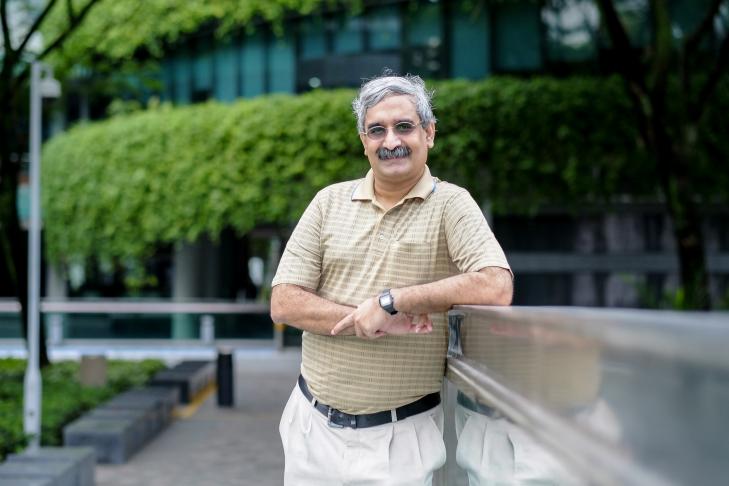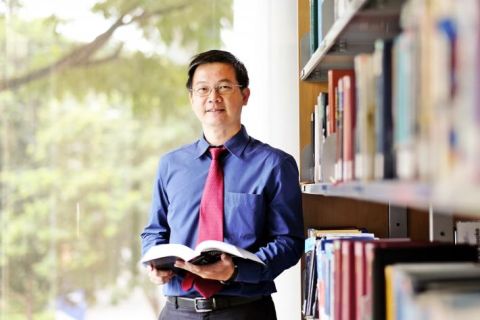
Can smartphones improve our quality of life and make cities run more efficiently? SMU Associate Professor Rajesh Balan is working towards this vision.

Photo Credit: Cyril Ng
By Sim Shuzhen
SMU Office of Research – Mobile devices such as smartphones are now so widely and intensely used that they have almost become extensions of the human body. Can we take advantage of this connectivity to save time, improve quality of life, and make cities run more efficiently?
Moving towards this vision is Associate Professor Rajesh Balan at the Singapore Management University (SMU) School of Information Systems, who develops novel mobile computing technologies for diverse applications, including traffic management, digital wallets and social networking. He is also co-director of the SMU LiveLabs Urban Lifestyle Innovation Platform, a unique test bed for mobile technologies.
“This idea of creating live test beds is very exciting as it is unique and extremely useful not just for academic researchers, but also for companies that want to understand their customers better,” Professor Balan says. “It also meshes very well with the government’s plan to develop Singapore into a smart city.”
Mobile computing in public transport
Professor Balan was drawn to mobile computing because of its unique challenges. Like most other computing disciplines, the field makes use of technology to solve technical problems, such as extending the battery life of a smartphone. At the same time, however, human-centric technologies are also needed so that people will be willing to use the phone. “Whatever I develop has to be both technologically innovative and impressive, as well as easy to use and engaging,” he explains.
One of Professor Balan’s earlier projects involved working with a large taxi company in Singapore to build a real-time trip information system. By rapidly searching a huge database of historical data, the system could predict the duration of any taxi trip to within one minute, and the fare to within 50 cents. It also took into account variables such as traffic conditions and Singapore’s taxi fare structure, which charges different rates depending on the day of the week and the time of day.
The project, “Providing Real-Time Feedback for a Large Taxi Fleet”, was published in 2011 in Proceedings of the 9th International Conference on Mobile Systems, Applications, and Services. Besides taxis, the system also has potential to be useful to bus and train operators, as well as to logistics companies looking to improve their operations.
Society as a living laboratory
For Professor Balan, solutions to research questions should always be useful to people. In 2012, this focus on the end-user led him and colleague Associate Professor Archan Misra to start LiveLabs, a platform that enables researchers to test lifestyle-related mobile computing technologies on real people in real environments. LiveLabs is currently available across the SMU campus, with 3,000 students voluntarily signed up thus far. It is also being expanded to other public spaces such as the Suntec Convention & Exhibition Centre and Sentosa.
“This kind of in situ, real-time, mobile-based behavioural test bed is unavailable anywhere else in the world,” notes Professor Balan. In LiveLabs, a marketing researcher could, for example, send students working in the library two different promotions on their smartphones: a standard discount for ten percent off a cup of coffee, or a more social “buy one coffee get one free” promotion. The researcher can then observe which version proves more popular. Using sensors already existing in participants’ smartphones, malls can send out personalised, location-specific shopping recommendations and discounts. To safeguard individual privacy, participation would be opt-in, and sensitive information would be removed from all the collected data.
Trials of many different mobile technologies are now underway at LiveLabs, including detecting the location of free tables and chairs in the library, automatic tracking of food consumption using a smart watch, and peer-to-peer mobile gaming that allows train commuters to play games with each other without using data networks.
The future: a nation of smart citizens
Professor Balan believes that in the near future, mobile connectivity can be leveraged to create the concept of a “smart citizen”, where “each individual will play a much stronger role in the welfare and upkeep of their environment”.
For example, trash cans are now emptied only when cleaning staff physically make their rounds. With the smart citizen concept, anyone who sees a full trash can can immediately report it—through a mobile app or a web form, for instance—and activate the cleaning staff. Customers in the supermarket can report how many people are ahead of them at the checkout counter, and commuters can provide feedback on the status of subway lines.
By providing the right incentives, an advanced version of this concept could even get people to perform micro-tasks on behalf of others. For example, an elderly person who needs a carton of milk would simply state this request into an app. The app would then find someone whose route would take him past the grocery store as well as the elderly person’s home; he could then be asked to buy and deliver the milk at only a small inconvenience to himself. In return, he would be rewarded—with vouchers sponsored by a company, for instance.
“This would open up completely new and innovative ways for people to help each other, while receiving something in return for their help,” he says. “I see a future where everyone is connected with everyone else, and where those connections can be used to improve society as a whole.”
See More News
Want to see more of SMU Research?
Sign up for Research@SMU e-newslettter to know more about our research and research-related events!
If you would like to remove yourself from all our mailing list, please visit https://eservices.smu.edu.sg/internet/DNC/Default.aspx
